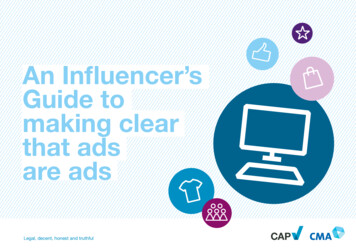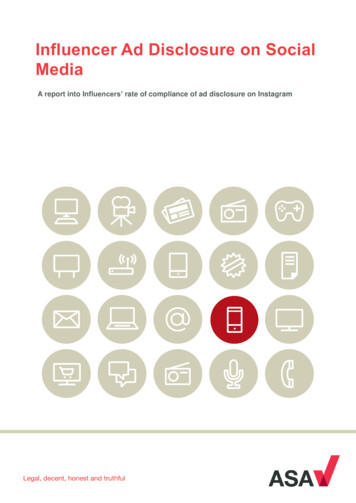
Transcription
An Influencer’sGuide tomaking clearthat adsare adsLegal, decent, honest and truthful
Table ofcontentsLegal, decent, honest and truthfulWho are you?1What are the rules?2What counts as an ad?3- Affiliate marketing4- Advertorial5What counts as ‘payment’ for advertorial content?6What counts as ‘control’ for advertorial content?7What if there’s ‘payment’ but no ‘control’?8How do I make clear that ads are ads?9What are the CMA’s requirements?11What else do I need to remember?12Infographic: Is my post an ad and do I need to label it?13What happens when someone complains to the ASA?14Where can I get help? – CAP16Where can I get help? – CMA17Where can I get help – More18
Whoare you?The Advertising StandardsAuthority (ASA) is the UK’sadvertising regulator. The ASAmakes sure ads across UKmedia stick to the advertisingrules (the Ad Codes).The Committee ofAdvertising Practice (CAP),whose members representadvertisers, media ownersand agencies, is responsiblefor writing the Ad Codes.Together, we work to makeads responsible. We do thisby taking action againstmisleading, harmful or offensiveadvertising and providingadvice and training to helpbusinesses get their ads right.1Legal, decent, honest and truthfulThe Competition andMarkets Authority (CMA)is the UK’s primary competitionand consumer authority. We arean independent non-ministerialgovernment department withresponsibility for carrying outinvestigations into mergers,markets and the regulatedindustries and enforcingcompetition and consumer law.If we have concerns that amarket or business practicemay be harming consumerswe can investigate and takelegal action to stop it.For more information on theCMA see our homepage.
What arethe rules?Just because an ad is covered by theCAP Code, this doesn’t mean it’s aproblem – it just needs to follow the rules.There are lots of rules that could apply, dependingon the circumstances, but it’s worth paying particularattention to the UK Code of Non-broadcastAdvertising and Direct & Promotional Marketing(the CAP Code) and the Consumer Protectionfrom Unfair Trading Regulations 2008 (CPRs).The CAP Code, enforced bythe ASA, applies to most formsof influencer marketing. Justbecause an ad is covered by theCode, this doesn’t mean it’s aproblem – it just needs to followthe rules. The Code is brokenup into sections containing rulesthat relate to different subjects.For example, Section 2 containsrules about how ads shouldbe recognisable as ads, andSection 3 sets out rules thatadvertisers must followto avoid misleading people.Consumer protection legislation,enforced by the CMA, alsoapplies to influencer marketing.2Legal, decent, honest and truthfulThis makes ‘unfair commercialpractices’, including using‘editorial content in the media topromote a product where atrader has paid for the promotionwithout making that clear inthe content or by images orsounds clearly identifiable by theconsumer (advertorial)’ againstthe law. Other practices whichmay break the law are falselyclaiming or giving the impressionthat an individual is acting outsideof their business purposes orfalsely representing themselvesas a consumer; failing to identifya commercial intent behind asocial media post; and omittingor hiding ‘material’ information.
Whatcountsas an ad?There are a few different ways in which somethingyou post could count as ‘advertising’ and fall underthe rules in the CAP Code, including:Paid-for spaceThe most obvious way tomake something an ad isto pay for it to appear in‘paid-for ad space’, whichmeans space that is normallyused for ads, e.g. banner ads,paid-for search results and the‘sponsored/promoted’ postson social media platforms.3Legal, decent, honest and truthfulOwn advertisingIf you’re posting about yourown products/services; e.g.,products you sell and eventsyou’re running etc., then thisalso counts as advertising –even on your own personalchannels. The same goes forany prize draws or giveawaysyou do (these are ‘promotionalmarketing’ and you would bethe ‘promoter’).
What countsas an ad?– AffiliatemarketingFor affiliate ads,you are effectivelyacting as a secondaryadvertiser so you needto make sure that yourcontent follows all ofthe relevant rules.4Legal, decent, honest and truthfulAffiliate marketingWhen your content promotesparticular products or servicesand contains a hyperlink ordiscount code that meansyou get paid for every ‘clickthrough’ or sale that can betracked back to your content,this counts as advertising.If there are affiliate links ordiscount codes for only someof the products mentionedin your content, and the restyou’ve mentioned in a purelyeditorial capacity (i.e. there’sno affiliate link), then only thebits of the content that relateto affiliate-linked products areads, rather than the post as awhole. In that case, you onlyneed to make clear that thosebits are advertising.Obviously, if all of the contentis about affiliate-linkedproducts, the whole thing’san ad and you’ll need to makeclear upfront that the wholeof the content is advertising.For affiliate ads, you areeffectively acting as asecondary advertiser so youneed to make sure that yourcontent follows all of therelevant rules, not just theones on making clear thatit’s advertising.
What countsas an ad? –AdvertorialIf you work with a brand to create some contentthat you’ll be posting on your own channels, it’llqualify as an ad if the brand:1. ‘ paid’ you in some way(can be freebies, doesn’thave to be money), andIt’s not an ‘either/or’ – there hasto be both ‘payment’ and ‘control’for this type of post to count asan ad under the CAP Code.5Legal, decent, honest and truthful2. h ad some form of editorial‘control’ over the content,including just final approval.It’s not an ‘either/or’ – therehas to be both ‘payment’ and‘control’ for this type of postto count as an ad under theCAP Code.However, consumer protectionlegislation still applies wherethere has been ‘payment’ (i.e.any form of monetary payment,a loan of a product/service, anyincentive and/or commission orthe product/service has beengiven free) but no ‘control’ andthis is enforced by the CMA.
What countsas ‘payment’for advertorialcontent?Obviously, if you’re paid a specified amount ofmoney to create and/or post a particular pieceof content, this counts as ‘payment’.products, gifts, services, trips, hotelstays etc. for free, this is all likely toqualify as a ‘payment’6Legal, decent, honest and truthfulBut this isn’t the only typeof arrangement that counts.If you have any sort ofcommercial relationship withthe brand, such as beingpaid to be an ambassador,or you’re given products, gifts,services, trips, hotel staysetc. for free, this is all likely toqualify as ‘a payment [or otherreciprocal arrangement]’.There’s nothing wrong withgetting paid to create contentand this alone doesn’t makeit an ad for the purposes ofthe CAP Code; the brand alsoneeds to have some sort ofcontrol over the content.
Whatcounts as‘control’ foradvertorialcontent?7Legal, decent, honest and truthfulWhether or not a brand has ‘control’ over aninfluencer’s post will usually depend on theagreement you have with them. As a rule ofthumb, if you weren’t completely free to do andsay whatever you wanted whenever you wanted,then there could have been some level of editorial‘control’ by the brand.The simplest way for a brandto ‘control’ the content is bytelling you what you have tosay, e.g. if there are particularwords, phrases, themes or‘key messages’ you need toinclude, or you have to usea particular hashtag.This doesn’t just apply to textor words – if the brand hasspecified what needs to bein an image, required you toinclude a specific action in avideo or specified the type ofcontent you need to create (e.g.‘unboxing’ the featured product),this is likely to count as ‘control’.Requiring you to post a specificnumber of times, on certaindates or at particular timescould also count as ‘control’.If a brand reserves the rightto check/approve the contentbefore it’s posted and/or toask you to change it, this couldsimilarly count as ‘control’.They don’t need to actuallyask for changes – if they could,and you would have to do it(e.g. they could stop you fromposting), that’s enough.
What if there’s‘payment’but no‘control’?If you’ve been ‘paid’ (either in money or ingifts/freebies), but it isn’t as part of an affiliatearrangement and the brand doesn’t have any‘control’ of what (or even if) you post, it’s unlikelythat the content will count as advertising underthe CAP Code.Sponsorship isn’t covered by theCAP Code, and the ASA won’tpursue complaints about it.8Legal, decent, honest and truthfulIn that case it’s a little likesponsorship, in the way thatevents and TV programmescan be sponsored – thesponsor has no ‘control’ overthe actual content of whatthey’re sponsoring, they’rejust helping to fund its creation(and paying for an associationwith that content).Sponsorship isn’t coveredby the CAP Code, and theASA won’t pursue complaintsabout it.That said, arrangements likethis are still subject to regulationunder consumer protectionlegislation enforced by theCompetition and MarketsAuthority (CMA). The CMAexpects influencers to disclosewhen they’ve received any formof monetary payment, a loan of aproduct or service, any incentiveand/or commission or have beengiven the product they’re postingabout for free. The CMA haspublished some more informationon this here and here.
How doI make itclear thatads are ads?Under the CAP Code ads ‘must be obviouslyidentifiable as such’. This means that consumersshould be able to recognise that something is anad, without having to click or otherwise interactwith it. Since it needs to be ‘obvious’, consumersshouldn’t have to work too hard to figure it out.Most influencer marketingappears alongside independent/editorial content in a verysimilar style, so it often isn’timmediately obvious whensomething is or isn’t an adfrom the context alone.Both you (acting as a ‘publisher’)and the brand are responsible forensuring that advertorial contentmakes clear that it’s advertising.vertAdAD9Legal, decent, honest and truthfulUltimately, if it’s not obvious fromthe context that something’s anad, more needs to be done withthe content to make this clear.If you are promoting your ownproducts or services on your ownchannels – provided it’s clear thatyou’re talking about your ownproducts – people are usuallyable to recognise that you’readvertising your own stuff.Affiliate marketing andadvertorial content, on the otherhand, are much less likely to beclear recognisable by contextalone, so this is where you mayneed to work a little harderto make it clear. There arepotentially loads of ways youcould make advertising content‘stick out’ as being advertising,but by far the easiest is toinclude a prominent label thatmakes this clear.
How do I make it clearthat ads are ads?At the moment we know thatthe ASA likes labels that justsay it how it is, e.g.: Ad#ADThe main thing to remember is that youneed to make it obvious - any label (or othermeans) you use to highlight the ad needsto be upfront (before people click/engage),prominent (so people notice it), appropriatefor the channel (what can you see andwhen?) and suitable for all potential devices(it needs to be clear on mobile too!). Advert Advertising Advertisement Ad/Advertising/Advertisement FeatureOther labels are riskier, andalthough it will always dependon the wider content andcontext, we usually recommendstaying away from: S ponsorship, Sponsoredcontent, Spon, #Spon, #Sp In association with T hanks to [brand] for makingthis possibleAD10Legal, decent, honest and truthful Just @ mentioning the brandThis is because the ASA haspreviously made clear thatlabels like this don’t tell thefull story and don’t go quitefar enough to make it obviousthat it’s advertising.The main thing to rememberis that you need to make itobvious – any label (or othermeans) you use to highlight thead needs to be upfront (beforepeople click/engage), prominent(so people notice it), appropriatefor the channel (what can yousee and when?) and suitable forall potential devices (it needs tobe clear on mobile too!).This means that burying thelabel in a sea of hashtags orputting it where it can only beseen by clicking ‘see more’ orclicking to view the full post,probably isn’t going to cut it.We recommend including it ‘atthe beginning’ – which mightmean in the title, thumbnail oron an image (if that’s all peoplesee at first).
What are the CMA’srequirements?If it’s not an ad covered by the CAP Code but youwere still ‘paid’ (in money or in kind), the consumerprotection legislation enforced by the CMA still applies.Consumers neeendorsd to knementow thehasbeIf this isen ‘paidn’t clear, your p for’.risks brosteakingthe law.Although it’s not illegal forbrands to pay people topromote their products inblogs, vlogs, tweets or otheronline articles – consumersneed to know the endorsementhas been ‘paid for’. If this isn’tclear, your post risks breakingthe law.The CMA expects brands,influencers and media agenciesto have made sure that thecontent is clearly identifiableas being ‘paid-for’, for exampleby prominently labelling posts/videos as ‘Advertisement11Legal, decent, honest and truthfulFeature’ or ‘AdvertisementPromotion’, and to have regardto the ASA/CAP guidelines.Commercial relationshipsmust be disclosed upfront,any views expressed by theinfluencer should be genuineand everyone involved shouldensure that there are robustcompliance processes in placethat accurately reflect therequirements of the law.The CMA has published somemore information on this hereand here.
What elsedo I need toremember?Make sureyou’ve got anidea of generallywhat the rulescover12Legal, decent, honest and truthfulMaking it clear it’s an ad is only the beginning.If you’re advertising your own products/servicesor engaged in affiliate marketing, then other rulesare likely to apply to your content too.Make sure you’ve got an idea ofgenerally what the rules cover,particularly if you are:-p romoting products subjectto lots of rules (like food orsupplements); or- making claims (you’ll needto back them up);- r unning your own ‘giveaways’and prize draws (seriously readSection 8).- advertising age-restrictedproducts (like gamblingor alcohol);But this is just a taster, the Codecovers a lot more than that.
Is my post an adand do I need to label it?STARTIs the post advertisingyour own products,services or events?YNHave you included acode or hyperlink aspart of an ‘affiliate’agreement, so youY get paid a commissionfor each time someoneclicks through and/ormakes a purchase?NNAre you receivingmoney for promotinga product/service/brandin this post?Are you sure that it'sclear from this postN alone - even to peoplewho don't usually followyou and across alldevices and platforms?YAre you receivingbenefits, freebies,free products,free visits, etc?NYHave you been toldto say specific thingsabout the product orto include specificinformation, includinghashtags or links?YYNYIt sounds unlikelythe post will beconsidered an ad underthe Code, so youprobably don't needto label it.Does the brand havefinal approval beforeyou post it or have theyreserved the right totell you to change it?YNNAre you posting itbecause you've agreedto do it a specificnumber of times, eitheron one particular dateor between a specificrange of dates?It’s likely to beconsidered ‘sponsored’content rather than an ‘ad’ underthe CAP Code, so not for the ASA.But CMA rules apply here – youmust make sure content is clearlyidentifiable as being paid-for.For example, by using the label‘advertisement feature’ or‘advertisement promotion’.YNJust the linksand sections of thecontent that relate to affiliateproducts are advertising forour purposes and you needto highlight this, e.g. witha clear 'ad' label before/next to the relevantcontent.www.cap.org.uk13Legal, decent, honest and truthfulIs it clear that it's anad (whether 'affiliate'or 'native'), ratherthan just sponsorededitorial content?YNYNIs all of thecontent aboutthe affiliateproduct(s)?It's an ad under theUK advertising rules!Is it immediately obviousthat it's an ad, beforepeople click on it?You need tomake it clear that the postis an ad (rather than just editorialor sponsored content). There arevarious ways you could do this butthe easiest is to include a labelthat's always visible before peopleclick anything. The ASA hasdecided that for now "ad" at thebeginning of the post doesthe job best.NICEONE!
What happenswhen someonecomplainsto the ASA?Every complaint the ASA receives is assessedagainst the Ad Codes. Many don’t raise any issuesor give the ASA a reason to contact you or toinvestigate further, and in those cases they justdismiss the complaint. If they need more informationin order to work out whether there’s a problem,someone will get in touch with you and the brand.Looking into a complaintIn the early stages, they’reusually just asking questions totry and work out if they need totake further action. There’s noneed to be worried, just tell themwhat they need to know and ifyou’ve made a mistake just holdyour hands up and say so. Weknow they can sometimes come14Legal, decent, honest and truthfulacross as a bit formal andscary, but they don’t meanto be - they’re regulators, it’sjust how they communicate.They’re always happy totalk to you if you’re unsureor concerned – we promisethey’re all nice, friendly peoplejust doing their best to keepUK advertising responsible.
What happens whensomeone complainsto the ASA?. the ASA usuallyprefer to work togetherwith you (and the brand)to resolve it so, whereappropriate, theywill try and resolveissues informally.15Legal, decent, honest and truthfulResolving things informallyIf there seems to be a problem,the ASA usually prefer to worktogether with you (and thebrand) to resolve it, by providingadvice and guidance or gettingyou (and the brand) to agreein writing that an ad will bechanged or removed. When theydo that, the case ends up on alist published every Wednesdayon the ASA website so they canbe transparent about the workthey’re doing. They don’t includemuch information and you cansee the list here.Investigating an adIf they have good reason toconduct a formal investigationyou (and the brand) will havea chance to respond to thecomplaint and they’ll keepyou involved throughout theprocess. When they’ve madean assessment, the ASACouncil (the independent juryresponsible for deciding ifthe rules have been broken)will need to make the finaldecision. These decisionsbecome rulings, which are alsopublished every Wednesday –you can see them here.What happens after a ruling?If there was a problem withyour content, you’ll need tochange or remove it (the samegoes for any similar content).If you don’t, you’ll no doubtbe hearing from the ASA againand, if that doesn’t work, CAP’sCompliance team will get intouch. The Compliance teamcan apply sanctions if theyneed to (but they’d preferit if they didn’t need to!).
Where canI get help?– CAPOnline GuidanceThere’s loads of free adviceon our website. Why nottry searching our AdviceOnline database? We’ve gotguidance on various topics– from alcohol to weight lossclaims and everythingin between.Online & Face-to-faceTrainingWe offer Advice:am seminarsand eLearning modules on awide range of topics, includingsocial media. Keep an eye outfor our webinars too!NewsletterFancy receiving topical tipsand guidance updates directto your inbox? Go aheadand sign up to our Insighte-Newsletter.Tailored AdviceWant to ask a question orsense-check your idea orcontent before you post it?Contact our Copy Adviceteam, either on 020 74922100 or through the website.It’s free and usually takes24 hours.You can also follow us (@CAP UK) on Twitter for the latest newsand guidance updates.16Legal, decent, honest and truthful
Where canI get help?– CMAce. guidanopenon beingstand honeorsingdnenehwervicess/stcudproonline.17Legal, decent, honest and truthfulHere are some more useful resources on this topic:For more advice and information from the CMA, see the resources below;Online reviewsand endorsements:information forbusinessesInformation and advice forbusinesses on how to complywith consumer protectionlaw in the online reviewsand endorsements sectors.Online endorsements:being open and honestwith your audienceCMA guidance on being openand honest when endorsingproducts/services online.ICPEN Guidelinesfor Digital InfluencersGuidelines from theInternational ConsumerProtection EnforcementNetwork (ICPEN) on onlinereviews and endorsements.
Where canI get help?– MoreThe Internet AdvertisingBureau (IAB) UK, thetrade association for digitaladvertising representingbrands, media owners,technology providers andagencies has created GoodPractice Guidelines andan infographic to help youwork out when and howto disclose content-basedand native advertising;Content & Native DisclosureGood Practice‘Do I Need to Disclose?’Infographic18Legal, decent, honest and truthfulThe Incorporated Societyof British Advertisers(ISBA), the organisationthat represents majorbrands, has created a setof template contractualterms for the industrythat influencers andbrands alike can use toensure proper commercialrelationships includingclauses that addresslabelling of content;Influencer MarketingManagement Resources
of influencer marketing. Just because an ad is covered by the Code, this doesn’t mean it’s a problem – it just needs to follow the rules. The Code is broken up into sections containing rules that relate to different subjects. For example, Section 2 contains rules about how ads should










